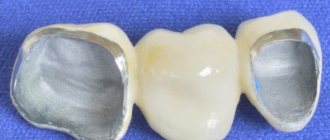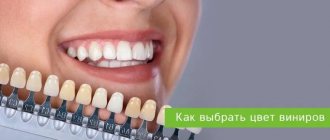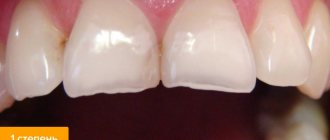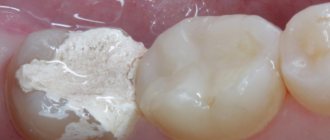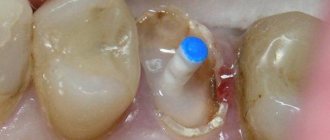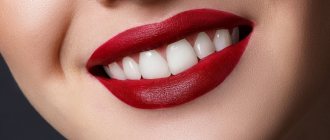What determines the color of teeth
It is believed that the color of the enamel determines the color of a person’s teeth, but in fact this is not entirely true. Tooth enamel can be milky white and translucent. Initially, in young people, it is quite dense and almost does not show through the underlying dentin, which in turn has a yellow, grayish or yellow-brown tint. The thicker the enamel, the whiter the teeth. The converse is also true.
Over the course of a person's life, the enamel becomes thinner and the color of the dentin appears. Hence the yellow or grayish smiles of older people. Food, drinks and tobacco also contribute to the darkening of teeth. Don’t forget about dental plaque and tartar, which absorb pigments much more strongly than enamel due to their porous structure.
A sudden change in the color of one or more teeth may indicate the presence of a disease. Thus, with fluorosis, teeth may acquire a brownish tint with whitish spots or stripes. Gray color occurs in pulpless teeth or may indicate heavy metal poisoning.
Causes of darkening and yellowing of enamel
- Individual characteristics and age
By nature, enamel can be yellowish, grayish or white. These are innate characteristics that are in no way related to external factors. It is possible to change the color of such enamel, but the possibilities are limited.
The same goes for age. Over the years, the color of teeth usually becomes darker. This is a natural process.
- Water composition
To a certain extent, fluoride contained in tap water is beneficial for teeth. But if its level is elevated, then the risk of fluorosis – dull white or yellowish spots on the surface of the enamel – increases. Fluorosis usually affects the visible surfaces of the teeth - the upper front incisors, and is very difficult to treat.
Fluorosis: dull white spots spoil the appearance of the enamel
- Dental care
Insufficiently thorough hygiene is the reason that plaque remains on the teeth and gradually hardens. In hard-to-reach places - between the teeth, near the roots - it mineralizes and turns into stone. Typically, such deposits acquire a yellowish, brown color, and can be almost black.
Tartar is hardened plaque
- Nutrition and habits
Black tea, coffee, and red wine leave dark pigments on the teeth. Smokers' teeth darken due to the fact that the tars contained in tobacco smoke settle on them. With frequent use, ordinary cleaning and even professional hygiene do not restore the natural whiteness of teeth, because the enamel itself darkens due to pigments.
- Other external factors
There are a number of medications that can affect the color of enamel. Moreover, the side effect can appear decades after treatment. Defects such as darkening due to medication are almost impossible to whiten, since the pigmentation in this case is located in the deep layers of the enamel.
Tetracycline teeth - darkening due to antibiotics
How to keep your teeth white
To keep your teeth white, you need to:
- Perform good oral hygiene, including brushing, flossing, and using mouth rinse
- Using a waterpik at least twice a week to get rid of plaque
- Once or twice a year, have your mouth professionally cleaned by a dental hygienist to remove tartar.
- Limit or eliminate smoking, strong tea and coffee
It is also important to make regular visits to the dentist for diagnostic procedures. This will allow timely identification of problems and identification of deterioration of the enamel.
Products hazardous to tooth color
Some products have the ability to color surfaces upon contact, especially porous tooth enamel, due to the presence of their own pigments:
- Black tea;
- cocoa;
- coffee;
- bright sauces (soy, curry, ketchup, etc.);
- colored fruits, including citrus fruits;
- vegetable and fruit juices;
- fruit drinks and compotes;
- carbonated drinks with dyes;
- chocolate;
- berries and jam;
- egg yolks;
- alcohol (red wine).
In the first two weeks, it is especially important to adhere to strict restrictions and recommendations of the dentist. After bleaching, the micropores open and absorb dyes faster. You need to exclude colored foods from your diet at least for the first time.
Teeth whitening and restoration techniques
If even careful care and regular professional hygiene do not allow you to completely get rid of yellowness, teeth whitening comes to the rescue. In our articles, we have already examined in detail the advantages and disadvantages of office and home whitening.
When darkening of the teeth is caused by severe thinning of the enamel, dental disease, or a general deterioration in the patient’s health, the first step is to correctly diagnose the problem and carry out appropriate treatment. Afterwards, it is possible to restore your smile with the help of veneers, lumineers and crowns.
We recommend that you try your best to keep your teeth healthy.
What are the ways to solve the problem?
Let's compare several main ways to correct the appearance of teeth.
| Problem | Solution |
| The enamel is naturally yellow or yellowed with age. | Teeth whitening in the clinic. This procedure can lighten teeth several shades, it is quick (30 minutes) and does not harm the teeth. Whitening should be repeated approximately once every 6 months. Home whitening products are less effective; results can only be achieved at home in 10–14 days and are likely to be less noticeable than in a clinic. Veneers can radically solve the problem and make teeth perfectly white. |
| Fluorosis | This is a damage to the enamel structure itself, and not to the surface layer. Minor fluorosis can be sanded down and then coated with fluoride varnish. Severe fluorosis cannot be completely removed; in this case, it is recommended to install aesthetic fillings or veneers. |
| Plaque or tartar | Soft plaque, which cannot be cleaned with a regular brush, can be easily and quickly removed in the clinic using Air Flow (treatment with a jet of water-soda solution under pressure). If the plaque has mineralized and turned into stone, it can be removed using ultrasonic cleaning. These two procedures are not interchangeable, they are needed for different purposes and are usually used sequentially in one appointment. After which the natural color of the enamel returns. |
| Darkening due to tea, coffee, smoking | In this case, a combination of procedures will help: ultrasonic cleaning, Air Flow and whitening. To avoid irritating the gums, it is better to carry out whitening not on the same day as brushing, but later. How often the procedure will have to be repeated to maintain the color depends on whether the habits are maintained. But on average, the result lasts from 6 to 12 months. |
| Darkening due to medication | This is a defect that cannot be removed by cleaning - darkening is associated with changes in the deep layers of enamel. Therefore, only veneers or crowns can give your teeth an ideal look. |
As can be seen from the comparison, there is no universal recipe. For aesthetic technology to be effective, you need to correctly assess the cause of the problem - for this it is best to consult a dentist.
Other articles:
- Can veneers correct crooked teeth?
- Aesthetic dentistry and its possibilities
What is teeth whitening and why is it important to do it?
Teeth whitening is an artificial method that lightens and cleans the enamel. The natural color of teeth is due to the color of dentin - bone tissue, the part of which protruding above the gum is covered with enamel. Enamel is not pure white: it is characterized by a slightly yellowish tint, which is less pronounced in some people. Absolute whiteness of teeth is as unnatural as the dark color of enamel, and this lightening effect is mainly achieved through the regular use of chemical bleaches, which, if abused, have a destructive effect on the enamel.
Under natural conditions, enamel is destroyed and darkens under the influence of various acids contained in certain foods (sweet drinks, confectionery and foods rich in carbohydrates). When such products are consumed, the enamel is destroyed, which acquires a porous, heterogeneous structure, and microscopic food particles are retained in such a surface, which give the enamel a yellow tint over time.
If you need to perform whitening, it is better to choose a method with the least negative impact on your teeth. In this regard, not the best teeth whitening is the one that is performed at home, and although such methods are suitable for one-time use, in general these procedures can only do harm. The optimal methods are considered to be Zoom technologies (in the last few years, a modification of this technology, Zoom 4, has been used, which uses an LED lamp with a cold LED light source, which eliminates overheating and makes the procedure safer than Zoom 3 and its predecessor methods).
Oral care
In addition to nutrition, you also need to pay attention to proper oral care so that teeth restoration after whitening is as fast and comfortable as possible. First of all, you should spend extra time brushing your teeth - you need to brush them about 2-3 minutes longer than usual, with a medium-hard or soft brush (depending on the condition of the gums). You should also regularly use dental floss to clean the interdental spaces, an irrigator and rinses containing fluoride (to strengthen the enamel).
In the first days after the whitening procedure, you should refrain from smoking at all; in the future, it is recommended to reduce to a minimum the number of cigarettes smoked per day. Women who actively use lipsticks and lip gloss will have to stop using such cosmetics in the first three days after whitening.
What can you eat after teeth whitening?
The post-bleaching diet includes foods high in fluoride, calcium and phosphorus, vitamins C, A and E, and those that do not have bright colors [3, 4]:
- white meat;
- white fish;
- eggs (whites only);
- cereals (rice, pearl barley, oatmeal);
- white beans;
- soft and mild cheese;
- milk (fermented milk products are allowed only after 2-3 days, including yogurt without dyes);
- butter;
- vegetable oil;
- mushrooms with light flesh (white, champignons);
- potato;
- light vegetables (peeled cucumbers, white bell peppers);
- pasta;
- boiled or steamed cabbage;
- white or clear drinks.
Food should be warm or cool - nothing icy or scalding.
What to eat after whitening
A colorless diet is based on foods that have a low risk of staining the enamel. Your diet should include more protein foods and foods rich in calcium and fluoride. Here is the full list of permitted products:
- milk and dairy products, yogurt without dyes, cottage cheese and sour cream, light cheeses;
- white meat (turkey, chicken breast, rabbit);
- white fish (cod, hake, pollock, flounder), shrimp, squid, mussels;
- egg white;
- pasta, white bread, oatmeal and rice, white beans;
- champignons, porcini mushrooms;
- potatoes, cabbage, zucchini, cucumbers, white onions, garlic;
- green apples, pears, melon, bananas, grapes;
- clear broths, clean water, uncolored drinks.
During this period, it is recommended to steam, boil, stew or bake in the oven. Dishes made from minced meat, omelettes, salads, cereals, purees, soft baked goods will be useful.
Why do you need to eat this kind of food after the procedure?
The fact is that after the procedure the enamel becomes porous and more susceptible, including to dyes. The coloring pigment, which is found in a number of foods and drinks, easily penetrates and is absorbed into the lightened enamel.
In addition, after whitening, the enamel becomes more sensitive, so in the first few days after whitening you should avoid eating sour, hot and cold foods. You should also avoid eating too hard foods.
The most dangerous period is the first two days after the procedure. For the first 48 hours, you must strictly adhere to a white diet, and in subsequent days, consume unwanted foods in minimal quantities.
The longer the restriction from forbidden foods continues, the longer the result of the procedure will be.



